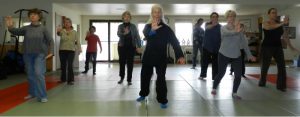Improve Low Back Pain with Tai Chi Practice Alone or with Other Treatments
By John M. de Castro, Ph.D.
“We would expect disability to improve because tai chi involves physical activity and exercise, and this would improve people’s ability to do physical tasks around the house, sports, work, etc.,” – Chris Maher
Low Back Pain is the leading cause of disability worldwide and affects between 6% to 15% of the population. It is estimated, however, that 80% of the population will experience back pain sometime during their lives. There are varied treatments for low back pain including chiropractic care, acupuncture, biofeedback, physical therapy, cognitive behavioral therapy, massage, surgery, opiate pain killing drugs, steroid injections, and muscle relaxant drugs. These therapies are sometimes effective particularly for acute back pain. But, for chronic conditions the treatments are less effective and often require continuing treatment for years and opiate pain killers are dangerous and can lead to abuse, addiction, and fatal overdoses.
Obviously, there is a need for safe and effective treatments for low back pain that are low cost and don’t have troublesome side effects. Mindfulness practices are effective in treating pain and have been shown to be safe and effective in the management of low back pain. Tai Chi is a mindfulness practice that is safe and gentle and has been shown to improve spinal health and reduce pain. The evidence is accumulating, so, it would seem reasonable to summarize what has been learned regarding the ability of Tai Chi practice to treat chronic low back pain.
In today’s Research News article “Effect of Tai Chi alone or as additional therapy on low back pain: Systematic review and meta-analysis of randomized controlled trials.” (See summary below or view the full text of the study at: https://www.ncbi.nlm.nih.gov/pmc/articles/PMC6750325/), Qin and colleagues review, summarize, and perform a met-analysis of the effectiveness of Tai Chi practice for the treatment of low back pain. They identified 10 randomized controlled trials employing a total of 959 participants.
They report that the studies found that Tai Chi practice either alone or in combination with other therapies significantly reduced low back pain level and the patient’s disability in comparison to control groups. Improvements in disability included pain intensity, personal care, lifting, walking, standing, sleeping, social life, and travelling. This summary makes it clear that Tai Chi practice is a safe and effective treatment for chronic low back pain.
Tai Chi is not strenuous, involving slow gentle movements, and is safe, having no appreciable side effects, it is appropriate for all ages including the elderly and for individuals with illnesses that limit their activities or range of motion. It can also be practiced without professional supervision and in groups making it inexpensive to deliver and fun to engage in. This makes Tai Chi practice an excellent means to treat with chronic low back pain.
So, improve low back pain with Tai Chi practice alone or with other treatments.
“Tai chi helps with back pain in several ways. It strengthens the muscles in your abdomen and pelvic area that are crucial to supporting the lower back; it improves your balance and flexibility; and it makes you more aware of your posture when you sit, stand, and walk.” – Benjamin Kligler
CMCS – Center for Mindfulness and Contemplative Studies
This and other Contemplative Studies posts are also available on Google+ https://plus.google.com/106784388191201299496/posts and on Twitter @MindfulResearch
Study Summary
Qin, J., Zhang, Y., Wu, L., He, Z., Huang, J., Tao, J., & Chen, L. (2019). Effect of Tai Chi alone or as additional therapy on low back pain: Systematic review and meta-analysis of randomized controlled trials. Medicine, 98(37), e17099. doi:10.1097/MD.0000000000017099
Abstract
Background:
This is the first systematic review evaluating and statistically synthesis the current studies regarding the effects of Tai Chi on pain and disability in patients with low back pain (LBP).
Methods:
Seven electronic databases including PubMed, EMBASE, Web of Science, Cochrane Library, China National Knowledge Infrastructure (CNKI), Wanfang and VIP information from inception to early March 2019 were searched. The Physiotherapy Evidence Database (PEDro) Scale was used to assess quality of all included randomized controlled trials (RCTs). The pooled effect size (weight mean difference, WMD) and 95% confidence interval (CI) were calculated to determine the effect of Tai Chi on pain and disability among LBP patients based on random effects model.
Results:
The aggregated results of the meta-analysis suggested that Tai Chi significantly decreased pain (WMD = −1.27, 95%CI −1.50 to −1.04, P < .00001, I2 = 74%) and improve function disability, Oswestry disability index (ODI) subitems: pain intensity (WMD = −1.70, 95% CI −2.63 to −0.76, P = .0004, I2 = 89%); personal care (WMD = −1.93, 95% CI −2.86 to −1.00, P < .0001, I2 = 90%); lifting (WMD = −1.69, 95% CI −2.22 to −1.15, P < .0001, I2 = 66%); walking (WMD = −2.05, 95% CI −3.05 to −1.06, P < .0001, I2 = 88%); standing (WMD = −1.70, 95% CI −2.51 to −0.89, P < .0001, I2 = 84%); sleeping (WMD = −2.98, 95% CI −3.73 to −2.22, P < .00001, I2 = 80%); social life (WMD = −2.06, 95% CI −2.77 to −1.35, P < 0.00001, I2 = 80%) and traveling (WMD = −2.20, 95% CI −3.21 to −1.19, P < .0001, I2 = 90%), Japanese Orthopedic Association (JOA) score (WMD = 7.22, 95% CI 5.59–8.86, P < .00001, I2 = 0%), Medical Outcomes Study Questionnaire Short Form 36 Health Survey (SF-36) physical functioning (WMD = 3.30, 95% CI 1.92–4.68, P < .00001), and Roland-Morris Disability Questionnaire (RMDQ) (WMD = −2.19, 95% CI −2.56 to −1.82, P < .00001).
Conclusion:
We drew a cautious conclusion that Tai Chi alone or as additional therapy with routine physical therapy may decrease pain and improve function disability for patients with LBP. Further trials are needed to be conducted with our suggestions mentioned in the systematic review.
https://www.ncbi.nlm.nih.gov/pmc/articles/PMC6750325/
